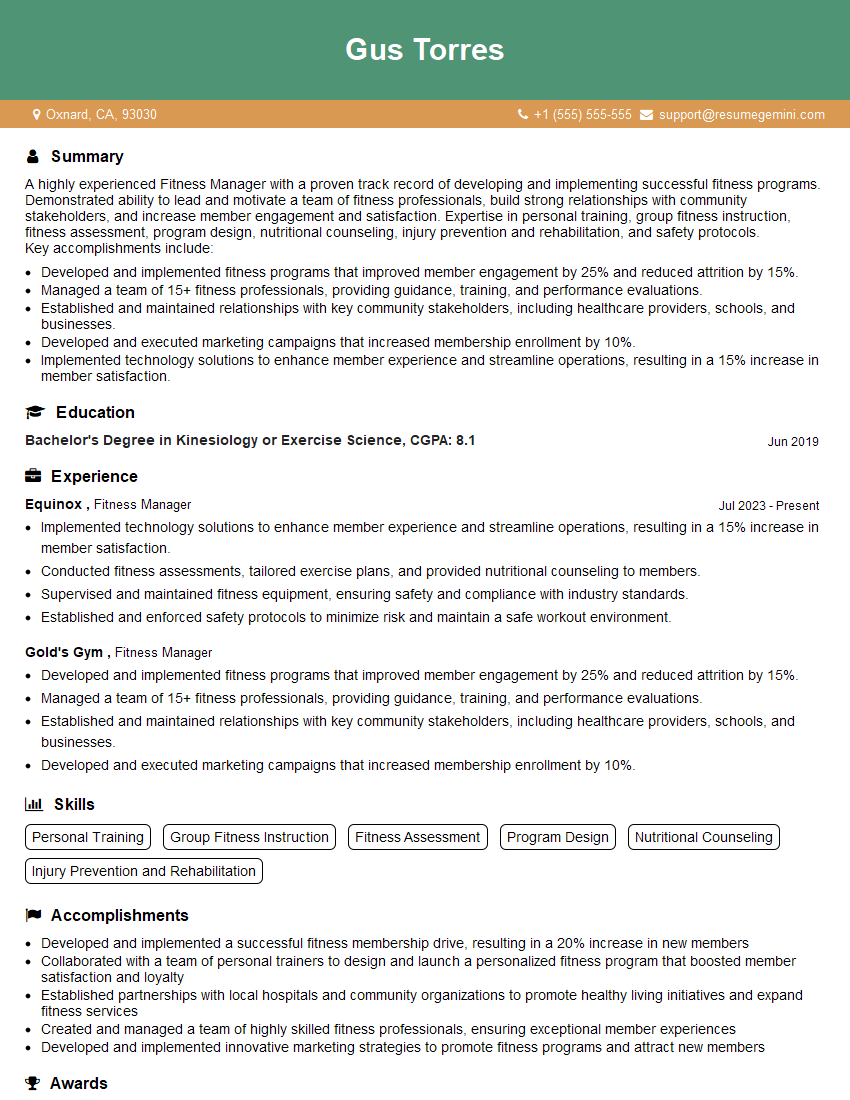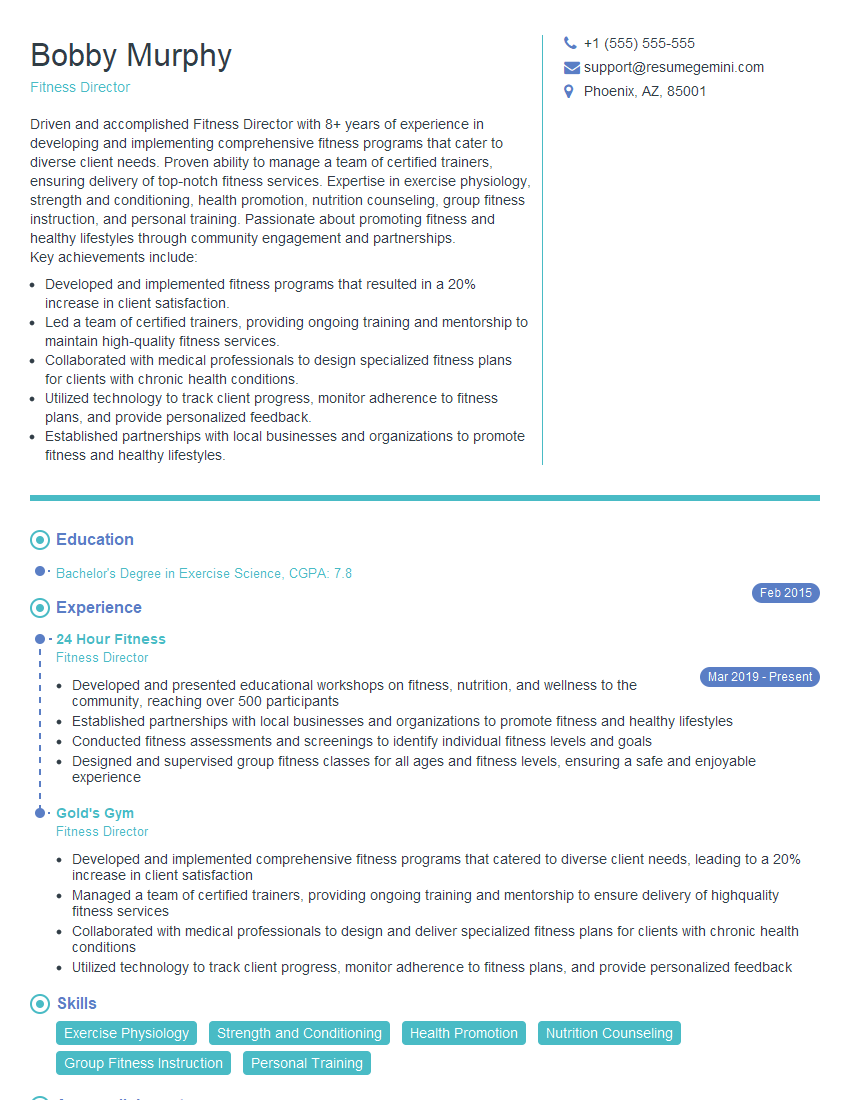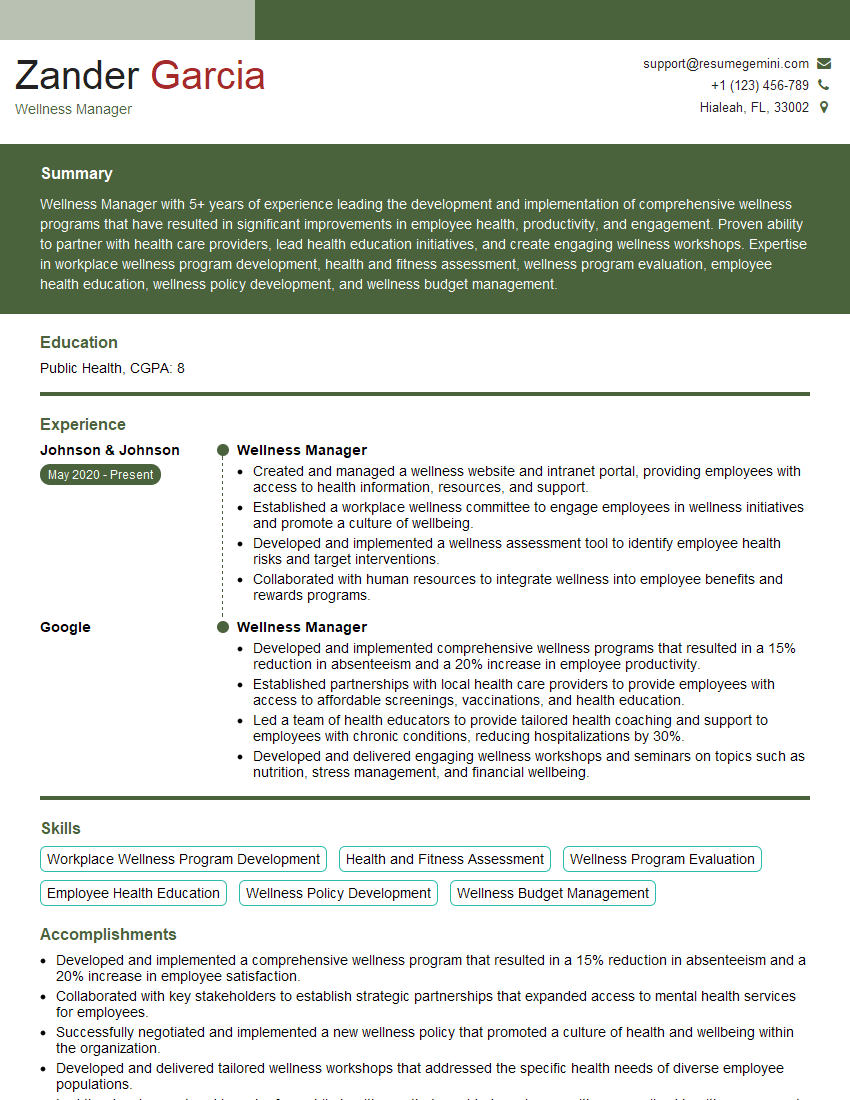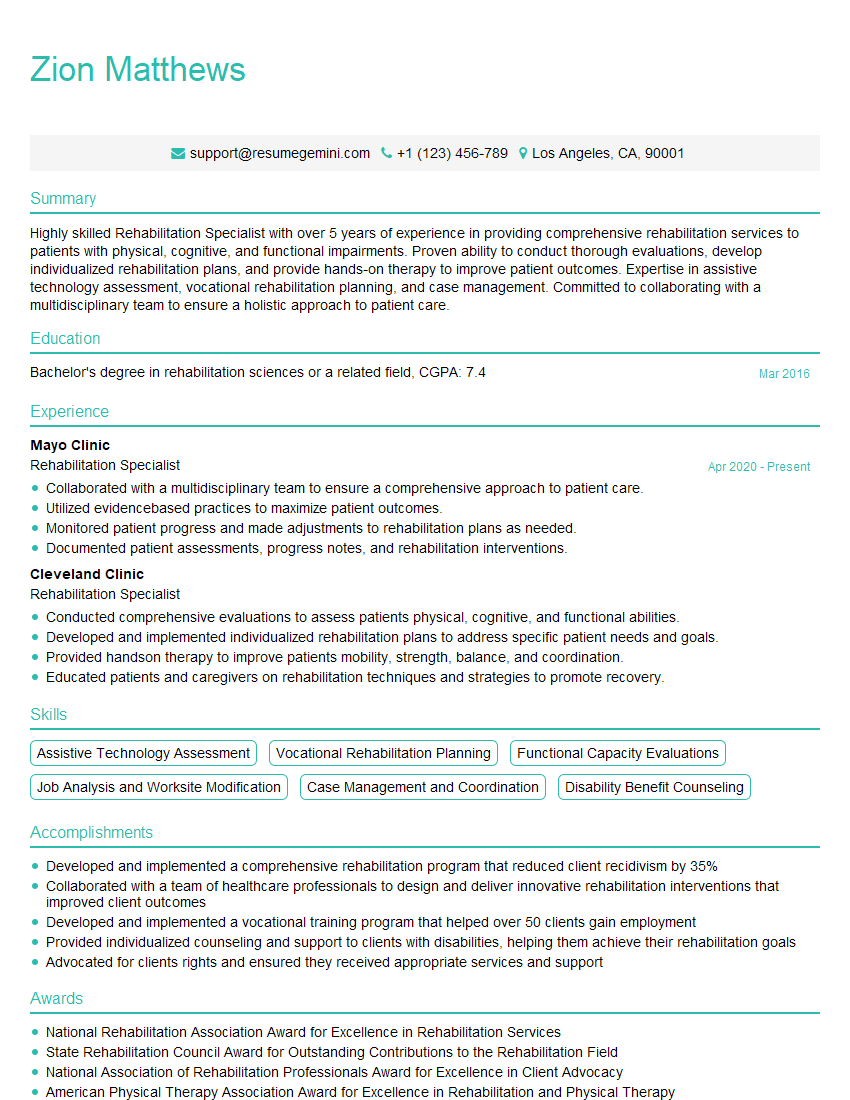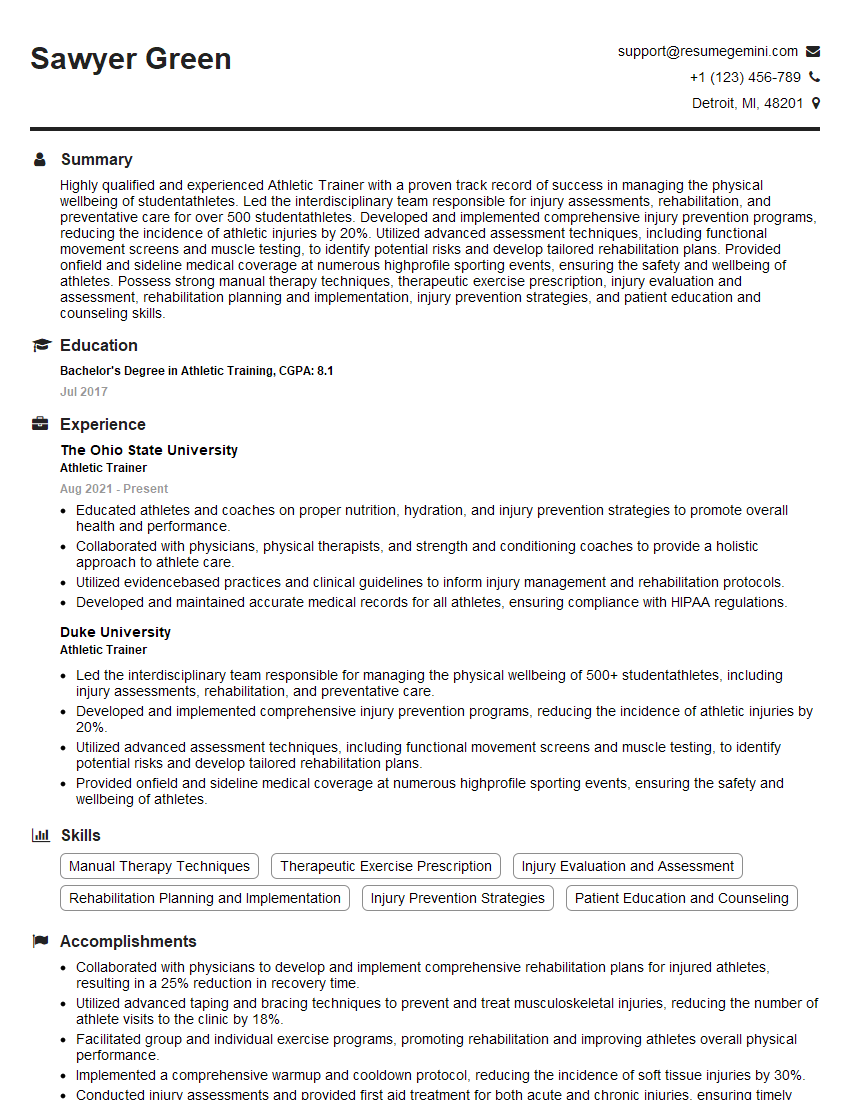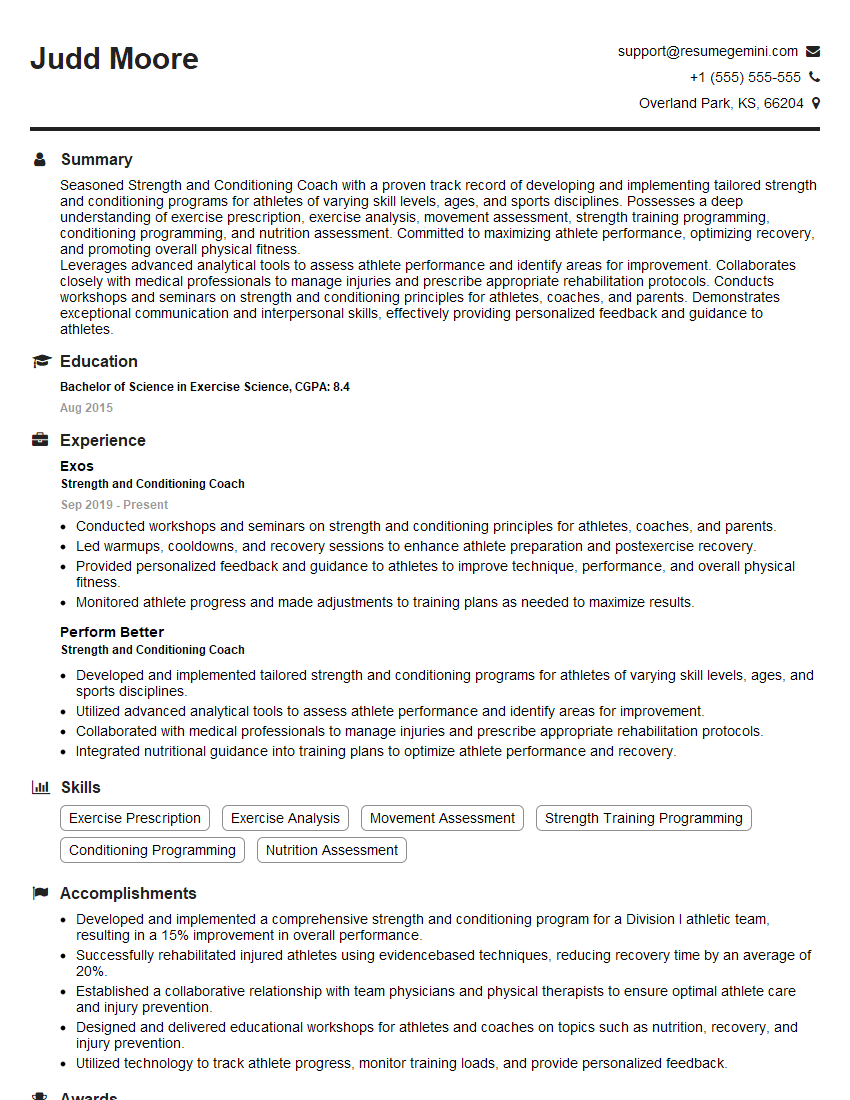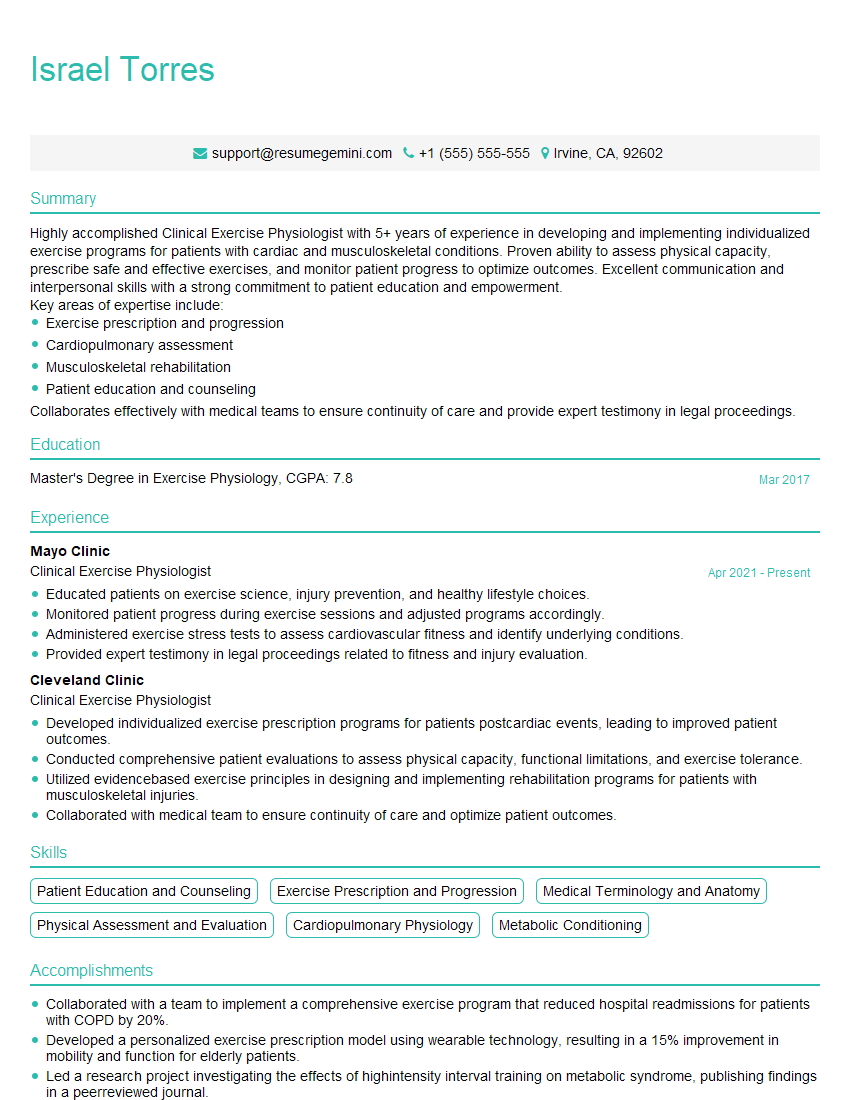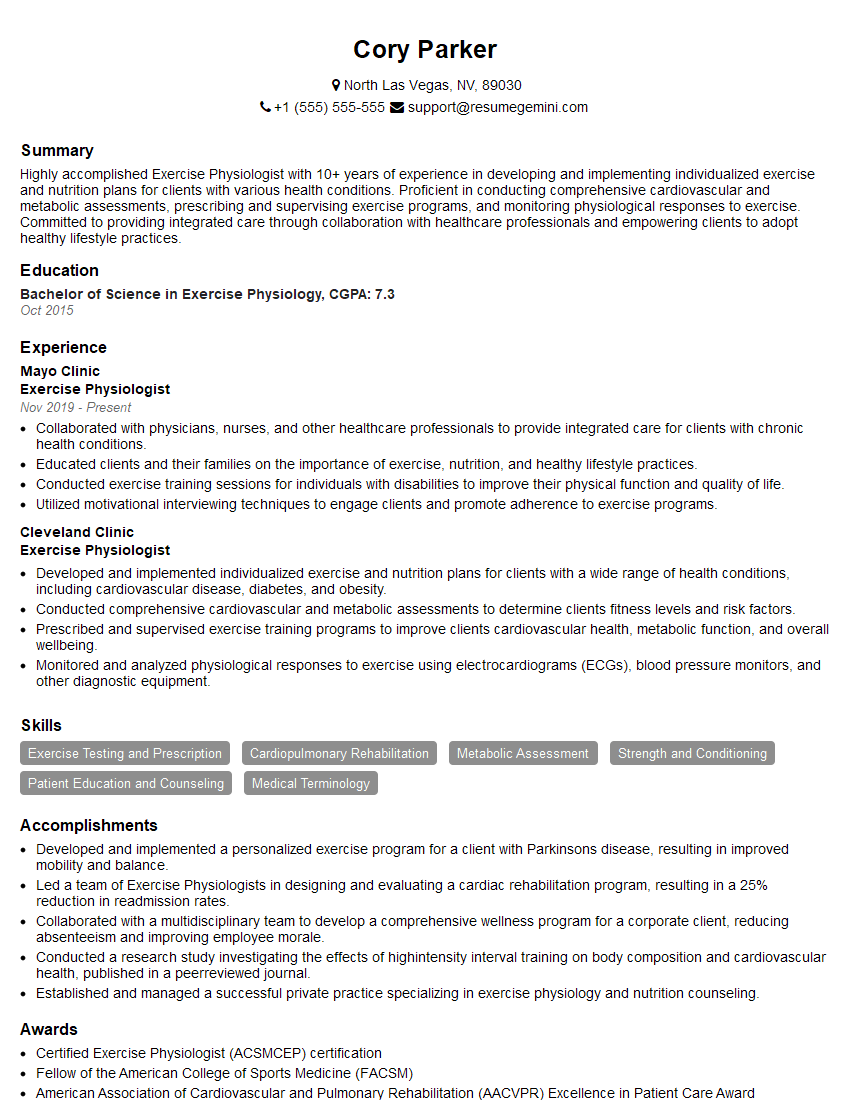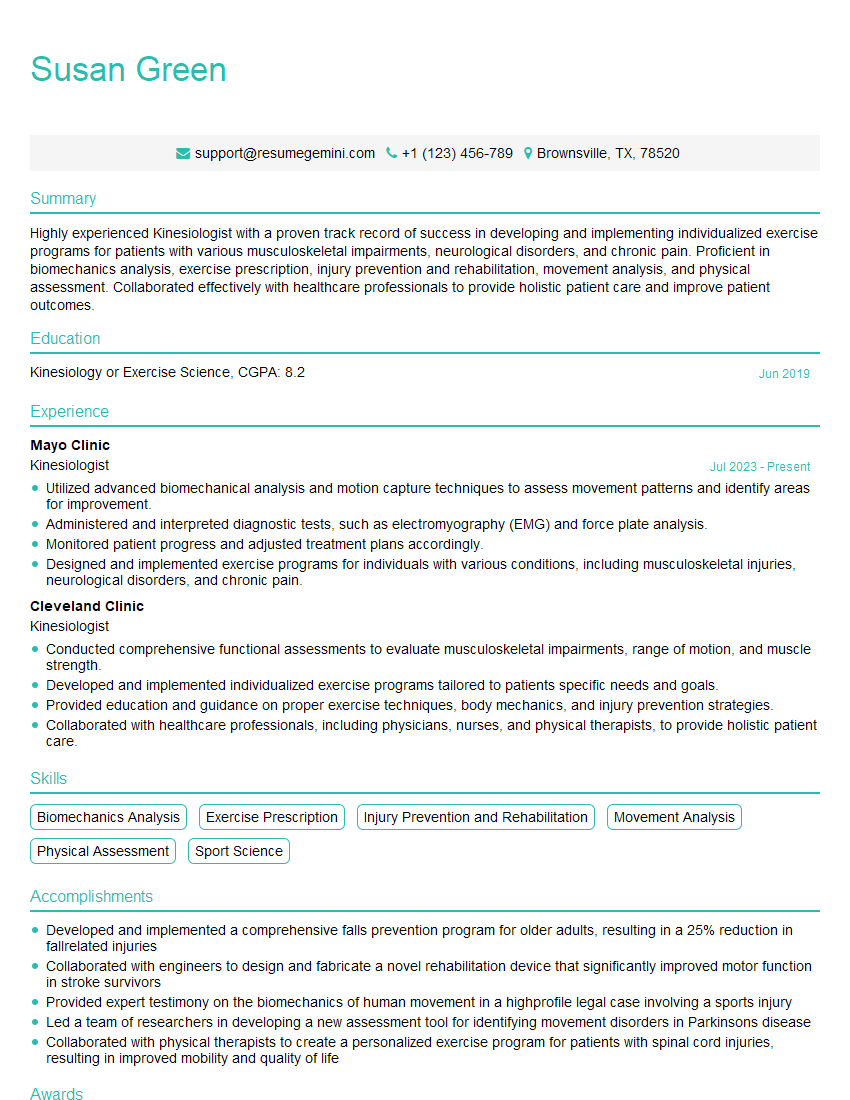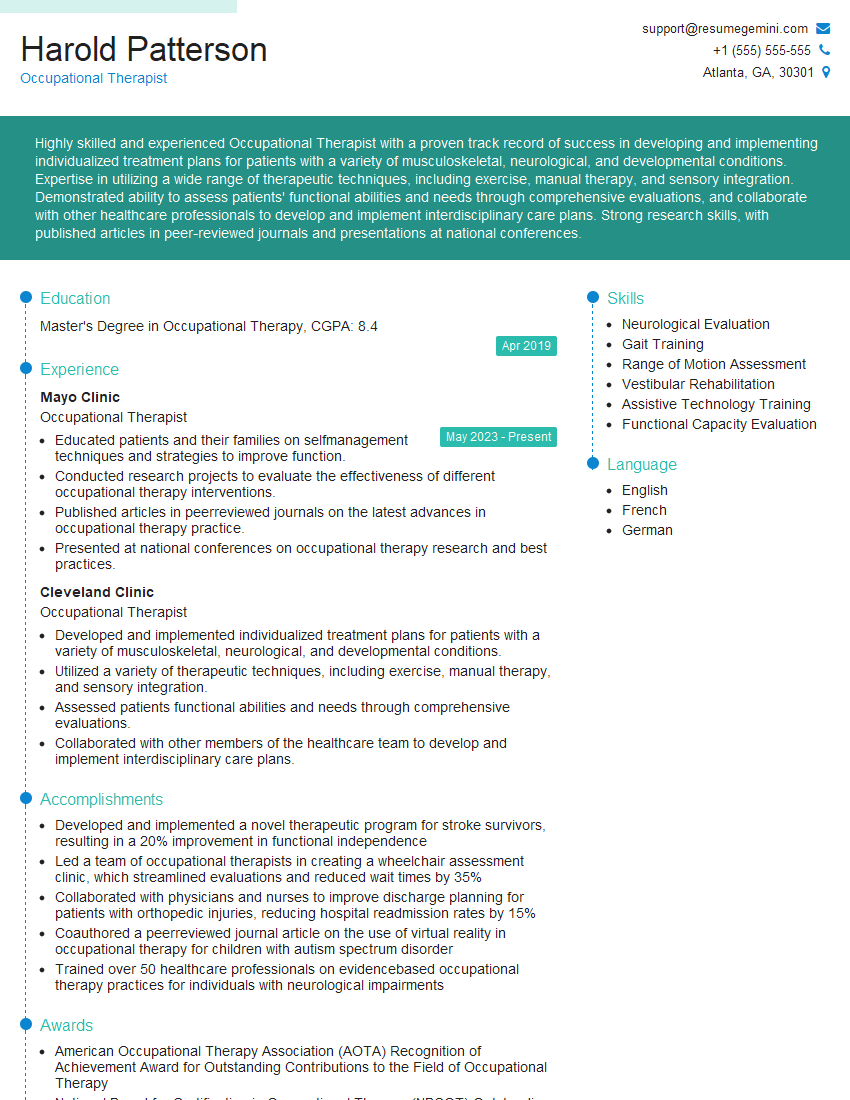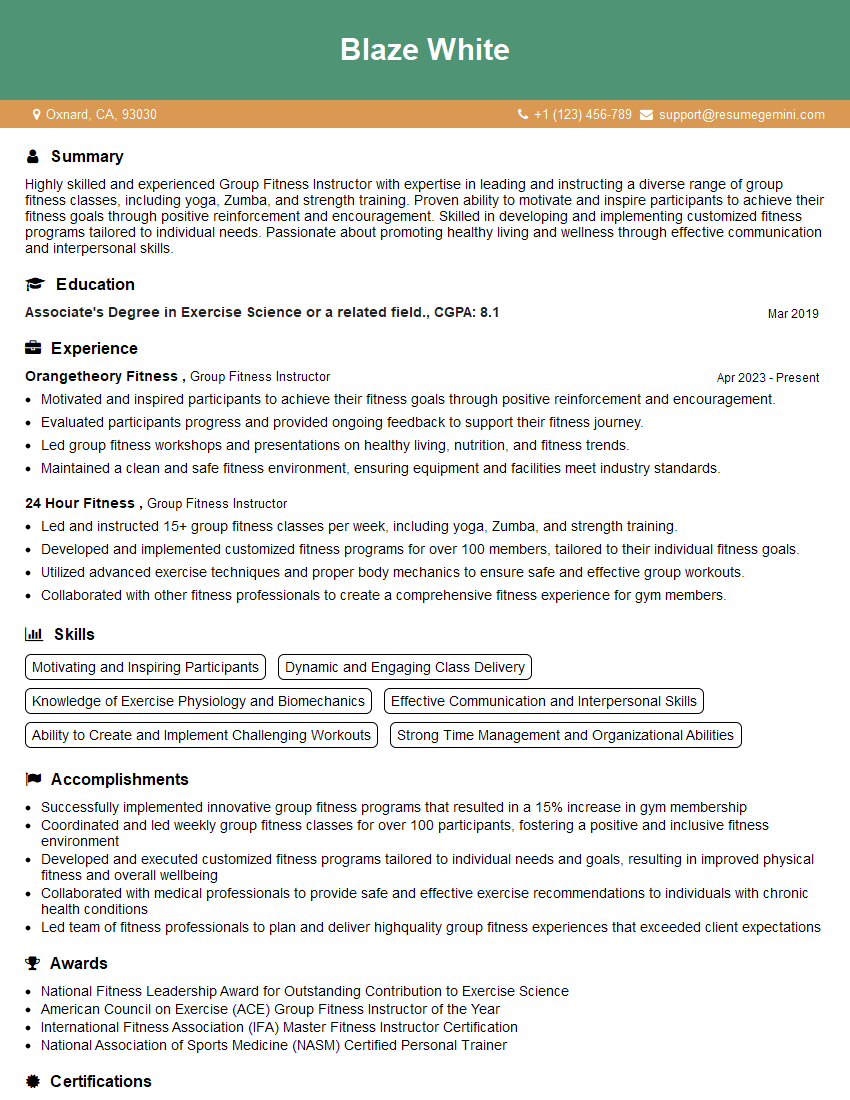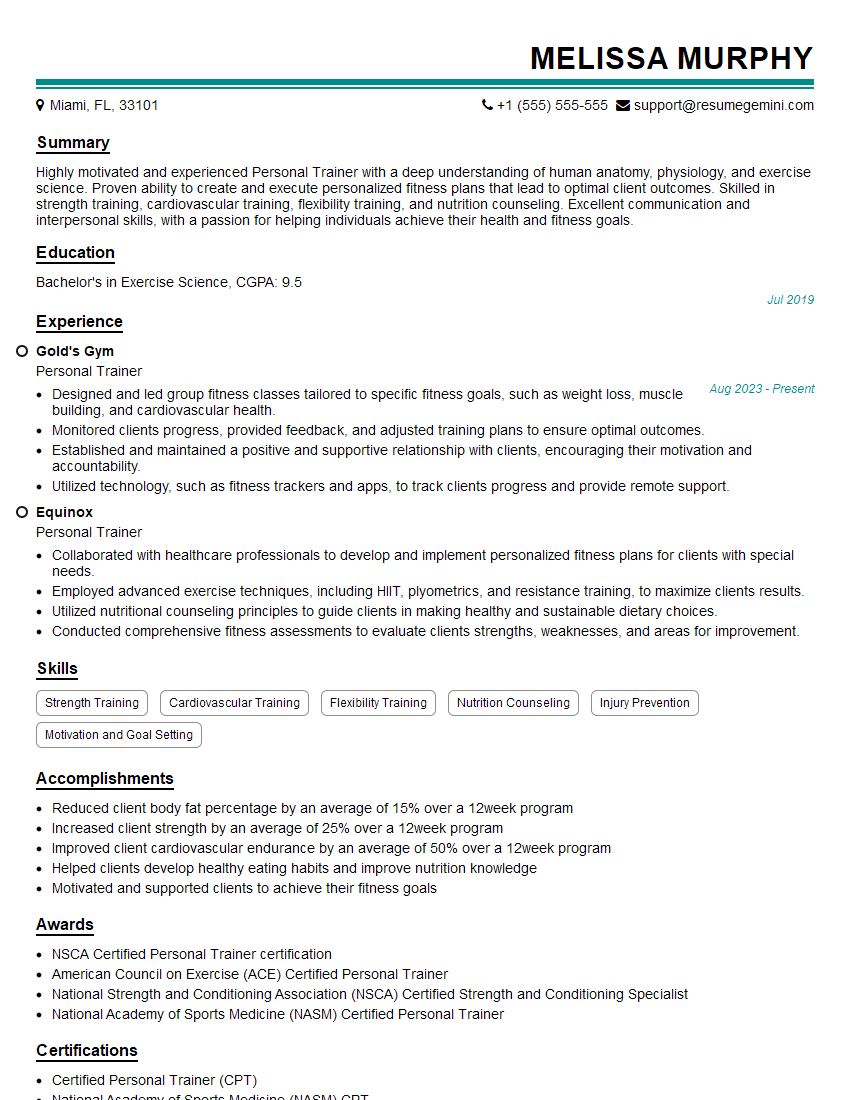Interviews are opportunities to demonstrate your expertise, and this guide is here to help you shine. Explore the essential Conditioning and Strength Training interview questions that employers frequently ask, paired with strategies for crafting responses that set you apart from the competition.
Questions Asked in Conditioning and Strength Training Interview
Q 1. Explain the difference between strength training and conditioning.
While often used interchangeably, strength training and conditioning are distinct but complementary aspects of fitness. Strength training focuses primarily on increasing the maximal force a muscle or muscle group can produce. Think of powerlifting – maximizing your one-rep max on squats, bench press, and deadlifts. Conditioning, on the other hand, encompasses a broader range of activities designed to improve various physiological systems, enhancing overall fitness. This includes aspects like cardiovascular endurance, flexibility, power, speed, agility, and recovery. A marathon runner, for example, focuses more on conditioning, though strength training might be incorporated to improve running efficiency. Essentially, strength training builds the foundation of strength, while conditioning builds the overall athletic capacity.
Q 2. Describe the principles of periodization in strength and conditioning.
Periodization is the systematic planning of training to optimize performance over time. It involves manipulating training variables – volume, intensity, and frequency – across different phases, cycling through periods of high intensity and volume followed by periods of lower intensity and volume for recovery and adaptation. A common model is the macrocycle (yearly plan), mesocycle (monthly plan), and microcycle (weekly plan). For example, a macrocycle might be a year-long training plan for a marathon. This would be broken down into mesocycles, focusing on different aspects like base building, strength development, and race preparation, which would further be divided into microcycles with specific weekly workouts. This structured approach prevents overtraining and maximizes athletic gains by tailoring the training load to the athlete’s current physical and mental state.
Q 3. What are the three energy systems and how do they relate to training?
The three energy systems fuel our movements:
- Phosphagen system (ATP-PCr): Provides immediate energy for short, high-intensity bursts (e.g., sprinting, weightlifting). It utilizes stored ATP and creatine phosphate. Training focuses on short, maximal efforts with long rest periods.
- Glycolytic system: Produces energy through the breakdown of carbohydrates. It fuels moderate-intensity activities lasting from a few seconds to a couple of minutes (e.g., 400-meter run). Training involves high-intensity intervals with shorter rest periods.
- Oxidative system: Provides long-term energy using carbohydrates and fats. It supports low-to-moderate intensity activities lasting longer than a few minutes (e.g., long-distance running). Training here focuses on prolonged, sustained efforts.
Understanding these systems is crucial for designing effective training programs. For example, a sprinter would prioritize training that maximizes the phosphagen system, while a marathon runner would focus on improving the oxidative system.
Q 4. Explain the concept of progressive overload.
Progressive overload is a fundamental principle of strength training that involves gradually increasing the demands placed on the body. This can be achieved by increasing weight, reps, sets, or changing the exercise to continuously challenge the muscles and stimulate further growth and adaptation. Think of it as systematically pushing your limits. For instance, if you’re able to bench press 100lbs for 8 reps, progressive overload might involve increasing the weight to 105lbs next week, or doing 10 reps with 100lbs. Failing to implement progressive overload will eventually lead to a training plateau, preventing further progress.
Q 5. How do you assess a client’s fitness level before designing a program?
Assessing a client’s fitness level is a crucial first step. I typically use a combination of methods:
- Health history questionnaire: Gathers information about pre-existing conditions, injuries, and medication.
- Movement assessments: Observe posture, range of motion, and basic movement patterns to identify any limitations or imbalances.
- Fitness testing: This could include measuring body composition (body fat percentage), cardiovascular fitness (e.g., VO2 max), muscular strength and endurance (e.g., 1RM, push-up test), and flexibility (e.g., sit-and-reach test). The tests selected depend on the individual’s goals and health status.
By combining these assessments, I get a comprehensive picture of the client’s strengths and weaknesses, allowing me to design a safe and effective training program tailored to their specific needs and goals.
Q 6. What are some common injuries associated with strength training and how can they be prevented?
Common injuries in strength training include muscle strains, sprains, tendonitis, and joint pain. Prevention strategies focus on:
- Proper form: Learning and maintaining correct exercise technique is paramount.
- Warm-up and cool-down: These prepare the body for exercise and aid recovery.
- Gradual progression: Avoiding sudden increases in training intensity or volume.
- Adequate rest and recovery: Allowing the body sufficient time to repair and rebuild.
- Proper nutrition and hydration: Fueling the body adequately and staying hydrated.
- Appropriate equipment: Using well-maintained equipment and wearing appropriate footwear.
- Listening to your body: Paying attention to pain signals and taking rest days when needed.
A good warm-up might involve 5-10 minutes of light cardio followed by dynamic stretching, and a cool-down might involve static stretches held for 20-30 seconds.
Q 7. Describe your experience with designing training programs for different populations (e.g., athletes, seniors, individuals with specific medical conditions).
My experience spans designing programs for diverse populations. I’ve worked with athletes across various sports, tailoring programs to enhance specific skills and performance metrics. For example, I designed a plyometric program for a basketball team to improve their vertical jump. With seniors, the focus shifts towards maintaining functional strength, mobility, and balance, often incorporating exercises that minimize joint stress and improve stability. I’ve also worked with individuals with specific medical conditions, always consulting with their physicians to ensure the safety and appropriateness of the training program. For instance, I adapted a strength training program for a client recovering from a knee injury, focusing on strengthening the muscles surrounding the knee while avoiding any movements that put undue stress on the joint. The key is always individualization: understanding each client’s unique needs and capabilities and tailoring the program to maximize their potential while minimizing risks.
Q 8. Explain the importance of proper warm-up and cool-down routines.
Proper warm-up and cool-down routines are crucial for injury prevention, performance enhancement, and overall training effectiveness. Think of it like preparing your car engine before a long drive and letting it cool down afterwards – you wouldn’t just jump in and floor it, right?
A good warm-up gradually increases your heart rate and body temperature, preparing your muscles and joints for the demands of exercise. This usually involves 5-10 minutes of light cardio, followed by dynamic stretching (movements like arm circles, leg swings) to improve range of motion and increase blood flow to the muscles.
Conversely, a cool-down helps your body gradually return to a resting state. It involves 5-10 minutes of light cardio and static stretching (holding a stretch for 20-30 seconds), which improves flexibility and reduces muscle soreness. Ignoring cool-downs can lead to increased muscle stiffness and delayed-onset muscle soreness (DOMS).
- Example Warm-up: 5 minutes of jogging, followed by arm circles, leg swings, torso twists.
- Example Cool-down: 5 minutes of walking, followed by hamstring stretches, quad stretches, and calf stretches.
Q 9. What are your preferred methods for tracking client progress?
Tracking client progress is vital for ensuring program effectiveness and making necessary adjustments. I utilize a multi-faceted approach:
- Regular Assessments: Strength testing (1RM for key lifts), body composition measurements (using calipers or DEXA scans), and flexibility assessments are conducted at regular intervals (e.g., every 4-6 weeks).
- Movement Quality Analysis: I observe clients’ form during exercises to identify any technical flaws that could hinder progress or increase injury risk. Video recordings can be incredibly helpful here.
- Client Diaries/Logs: Clients keep track of their workouts, including sets, reps, weight used, and perceived exertion (RPE). This helps identify patterns and potential issues.
- Subjective Feedback: Regular check-ins with clients allow me to gather feedback on their progress, any challenges they’re facing, and adjustments to their lifestyle, sleep, and nutrition that may affect results. This helps build rapport and personalize the training plan.
I then use this data to monitor progress, celebrate successes, adjust the program, and maintain motivation. For example, if a client plateaus on a particular lift, we can analyze their training log, assess their form, and perhaps implement a deload week or change their training split.
Q 10. How do you modify exercises for clients with limitations or injuries?
Modifying exercises for clients with limitations or injuries requires a deep understanding of biomechanics and anatomy. The goal is to maintain the training stimulus while reducing stress on the affected area. I begin by thoroughly understanding the client’s condition and any limitations from a medical professional (if applicable).
Modifications might involve:
- Reducing Range of Motion: Instead of full squats, we might do partial squats or box squats. For shoulder presses, we may use a lighter weight and reduce the range of motion if the client has shoulder impingement.
- Altering Exercise Selection: Replacing exercises that stress a specific joint with alternatives. For example, if someone has knee pain, we can replace barbell squats with leg presses or goblet squats.
- Using Assistance Devices: Resistance bands, weight machines, or bodyweight exercises are useful for modifying resistance and limiting stress on certain joints.
- Isometric Exercises: Holding a position under tension can build strength without significant joint stress.
Example: A client with a knee injury might replace barbell back squats with goblet squats, focusing on proper form and reducing the weight to minimize stress on the knee.
Q 11. Explain the concept of RPE (Rate of Perceived Exertion) and its application.
Rate of Perceived Exertion (RPE) is a subjective measure of how hard someone feels they are working during exercise. It’s a valuable tool for monitoring training intensity, especially for individuals new to training or those without access to advanced monitoring equipment. RPE is usually rated on a scale of 1-10, where 1 is very light and 10 is maximal exertion.
Application: RPE can be used to guide exercise intensity for various training goals. For example:
- Strength Training: For strength development, RPE 7-9 is commonly used to ensure sufficient challenge without compromising form.
- Endurance Training: For improving endurance, a lower RPE (e.g., 4-6) might be more appropriate for longer durations.
I often utilize the Borg Scale, a more detailed RPE scale which uses numerical values (6-20) that correlate to heart rate. This provides a more objective measure of exertion.
Q 12. Discuss the importance of nutrition in strength and conditioning.
Nutrition plays a pivotal role in strength and conditioning. It fuels muscle growth, recovery, and overall performance. Without adequate nutrition, training gains are severely limited. It’s like trying to build a house without bricks and mortar; you might have a great blueprint, but the building won’t stand.
Key nutritional considerations include:
- Sufficient Calorie Intake: Meeting daily energy needs to support training and recovery.
- Adequate Protein Intake: Providing the building blocks for muscle growth and repair (generally 1.6-2.2 grams of protein per kilogram of body weight for athletes).
- Carbohydrate Consumption: Replenishing glycogen stores for energy during workouts and recovery.
- Healthy Fats: Essential for hormone production and overall health.
- Hydration: Maintaining optimal hydration levels is crucial for performance and recovery. Dehydration can significantly impact strength and endurance.
I work closely with clients to develop individualized nutritional plans that align with their training goals, preferences, and any dietary restrictions or allergies. I often collaborate with registered dietitians for complex cases.
Q 13. What is your experience with different training methodologies (e.g., plyometrics, circuit training, HIIT)?
My experience encompasses a variety of training methodologies, each offering unique benefits:
- Plyometrics: Plyometric exercises, such as box jumps and jump squats, focus on explosive power development. I incorporate these into programs for athletes needing enhanced power output.
- Circuit Training: Circuit training involves performing a series of exercises with minimal rest, improving cardiovascular fitness and muscle endurance. This is great for fat loss and improving overall conditioning.
- HIIT (High-Intensity Interval Training): HIIT involves short bursts of intense exercise followed by brief recovery periods. This is very effective for improving cardiovascular health and burning calories in a shorter time frame. I often tailor HIIT protocols to specific client needs and goals, adjusting intensity and rest periods.
The choice of methodology depends on the client’s goals, experience level, and any physical limitations. I often integrate different methods to create well-rounded, effective training programs.
Q 14. How do you address client plateaus in their training?
Plateaus are inevitable in training. They indicate a need for adaptation. When a client hits a plateau, I systematically investigate potential causes and implement strategies to overcome it.
- Review Training Program: We analyze the current program, considering exercise selection, sets, reps, rest periods, and intensity. Minor adjustments, such as changing rep ranges or exercise variations, can often break through a plateau.
- Assess Technique: Proper technique is paramount. We reassess form, addressing any technical flaws that might be limiting progress.
- Consider Deload Weeks: Implementing a deload week (reduced volume and intensity) allows the body to recover fully, preventing overtraining.
- Adjust Training Variables: We might change the training split, introduce new exercises, adjust the training frequency, or incorporate different training methodologies.
- Address Nutrition and Recovery: I ensure that nutrition and sleep habits are optimized for optimal recovery and growth.
By systematically investigating and implementing these strategies, we can help clients overcome plateaus and continue to make progress. It’s a collaborative process, requiring open communication between the client and me.
Q 15. Describe your experience with designing and implementing strength and conditioning programs for specific sports.
My experience designing and implementing strength and conditioning programs for specific sports spans over a decade. I’ve worked with athletes across various disciplines, from elite-level runners needing explosive power to collegiate basketball players requiring agility and strength. My approach is highly individualized. I begin by conducting a thorough needs analysis, which includes assessing the athlete’s current fitness level, identifying their specific sport’s demands (e.g., speed, power, endurance), and understanding any potential injury history or limitations. This analysis informs the design of a tailored program addressing the specific energy systems, movement patterns and muscular demands of their sport.
For example, with a soccer player, I would focus on programs incorporating plyometrics for explosive movements, strength training for leg power and core stability, and agility drills to improve quick changes of direction. For a marathon runner, endurance building and injury prevention would be paramount, utilizing low-impact cardio exercises alongside flexibility and strength training to support running form and prevent injury. I also incorporate periodized training, adjusting the program’s intensity and volume throughout the training cycle to optimize performance and minimize risk of overtraining. Post-program evaluation and adjustments are a vital aspect, ensuring continued progress and safety.
Career Expert Tips:
- Ace those interviews! Prepare effectively by reviewing the Top 50 Most Common Interview Questions on ResumeGemini.
- Navigate your job search with confidence! Explore a wide range of Career Tips on ResumeGemini. Learn about common challenges and recommendations to overcome them.
- Craft the perfect resume! Master the Art of Resume Writing with ResumeGemini’s guide. Showcase your unique qualifications and achievements effectively.
- Don’t miss out on holiday savings! Build your dream resume with ResumeGemini’s ATS optimized templates.
Q 16. What are the benefits and risks of using supplements in strength and conditioning?
Supplements in strength and conditioning can offer benefits, but also carry significant risks. Benefits can include improved recovery, increased muscle protein synthesis (leading to enhanced muscle growth), and enhanced energy production during training. However, it’s crucial to remember that supplements are not a substitute for proper nutrition and training. Many supplements lack rigorous scientific backing, and some may even contain harmful substances or interact negatively with medications.
Risks associated with supplements include contamination with banned substances (leading to failed drug tests), liver damage, digestive issues, and potential interactions with prescription drugs. Therefore, I always advise clients to consult with both their physician and a registered dietitian before using any supplements. I advocate for prioritizing whole foods for nutrition and focusing on evidence-based training practices. If a client wishes to use supplements, I help them choose reputable brands with third-party testing and ensure the supplement aligns with their overall health goals and training program.
Q 17. How do you communicate effectively with clients about their progress and any concerns?
Effective communication is paramount. I use a multi-faceted approach. Regular check-ins, both in person and via email/phone, are vital. I utilize progress tracking tools, such as detailed workout logs, measurements (body composition, strength gains), and performance metrics relevant to their sport. These quantitative data points allow for objective assessment. Beyond the numbers, I also incorporate subjective feedback through questionnaires or informal conversations, assessing things like sleep quality, energy levels, and perceived exertion. This helps me to understand the bigger picture beyond the numerical data.
When addressing concerns, I prioritize active listening and empathy. I explain things clearly, avoiding jargon, and utilize visual aids if necessary (e.g., diagrams illustrating proper form, graphs showcasing progress). I always encourage open communication and provide a safe space for clients to voice concerns or anxieties. Transparency is key. I clearly explain the rationale behind my programming decisions and openly discuss any adjustments needed. This fosters trust and collaboration, leading to better outcomes.
Q 18. Explain your understanding of exercise biomechanics.
Exercise biomechanics is the study of human movement during physical activity. A strong understanding is crucial for designing effective and safe training programs. It involves analyzing the forces acting on the body, joint angles, muscle activation patterns, and movement efficiency. This knowledge allows me to identify potential movement compensations, optimize exercise selection for specific muscle groups, and minimize the risk of injury.
For example, understanding the biomechanics of a squat allows me to coach proper form, emphasizing maintaining a neutral spine, avoiding excessive knee valgus (knees collapsing inwards), and ensuring appropriate depth. This prevents injury and maximizes muscle activation. Similarly, knowledge of the biomechanics of a bench press enables me to identify potential issues like improper shoulder stabilization that can lead to rotator cuff injuries. I use this understanding to modify exercises or provide personalized cues to correct form and improve safety and efficiency.
Q 19. What is your approach to working with clients who have different learning styles?
I acknowledge that individuals learn in different ways – visually, auditorily, kinesthetically, or a combination. My approach adapts to this diversity. For visual learners, I provide detailed demonstrations, videos, and written instructions. For auditory learners, verbal explanations and cues are emphasized. Kinesthetic learners benefit from hands-on coaching, adjustments, and tactile feedback. I often blend these methods, providing a multi-sensory experience to cater to diverse learning styles.
For instance, when teaching a new exercise, I’ll first demonstrate it visually, then provide verbal cues, and finally guide the client through the movement, making physical adjustments as needed. I use a variety of teaching tools, including videos, diagrams, and physical models to further enhance understanding and retention. Regular feedback and open communication help me assess which approaches resonate best with each client, ensuring individualized learning support.
Q 20. How do you stay up-to-date with the latest research and trends in strength and conditioning?
Staying current in the ever-evolving field of strength and conditioning is critical. I regularly read peer-reviewed journals, attend conferences and workshops, and participate in continuing education courses. I actively follow reputable organizations like the National Strength and Conditioning Association (NSCA) and the American College of Sports Medicine (ACSM) to stay abreast of the latest research and best practices. I also actively engage in online professional communities and networks, participating in discussions and sharing knowledge with other professionals in the field. This ensures I’m always improving my practice and delivering the most effective and safest training protocols to my clients.
Additionally, I critically evaluate new training methods and technologies before implementing them into my practice, always prioritizing evidence-based approaches and client safety. I maintain a strong professional network, consulting with colleagues and specialists when needed to ensure the best possible outcome for each client.
Q 21. Describe your experience using different types of strength training equipment.
My experience encompasses a wide range of strength training equipment, from free weights (dumbbells, barbells, kettlebells) to machines (plate-loaded, selectorized), resistance bands, and bodyweight exercises. Each type of equipment has its advantages and disadvantages. Free weights are excellent for developing functional strength and stability, while machines offer more controlled movements and are often easier for beginners. Resistance bands provide variable resistance, and bodyweight exercises are highly accessible and versatile.
I select equipment based on the client’s goals, experience level, and available resources. I understand the biomechanics of each type of equipment and can modify exercises as needed to ensure safety and effectiveness. For example, I might use dumbbells for a client focusing on functional strength, a resistance band for a rehabilitation program, and a machine for a beginner needing more guided movement. My proficiency extends to setting up and safely using different equipment, while prioritizing client safety and proper form during every training session.
Q 22. How do you ensure the safety of clients during training sessions?
Client safety is paramount. My approach is multifaceted, starting with a thorough intake process including a detailed health history and physical assessment. This helps identify any pre-existing conditions or limitations. I then design programs that are individually tailored, progressively overloading the system, avoiding sudden or extreme increases in intensity.
Before each session, I check equipment for any damage and ensure the training environment is safe and clean. I carefully monitor clients during each exercise, providing immediate correction of form to minimize risk of injury. I also emphasize proper warm-up and cool-down routines. For example, I wouldn’t introduce heavy squats before establishing proper mobility and stability in the hips and lower back. Communication is key; I encourage clients to report any discomfort immediately, so adjustments can be made in real-time. Finally, emergency procedures, including access to first-aid supplies and contact information for medical professionals, are always in place.
Q 23. Describe your experience with creating and implementing a strength and conditioning program based on a specific goal (e.g. increase muscle mass, improve endurance).
I recently worked with a client aiming to increase muscle mass. We started with a thorough assessment of their current strength levels, body composition, and training history. The program focused on compound exercises targeting major muscle groups, such as squats, deadlifts, bench presses, and overhead presses. We incorporated a progressive overload principle, gradually increasing weight, reps, or sets over time.
The training split was a 3-day upper/lower routine, allowing adequate rest and recovery. Nutrition was a crucial component, emphasizing high protein intake to support muscle growth. We tracked progress using measurements like weight, body fat percentage, and strength improvements in key lifts. We adjusted the program based on feedback and progress, ensuring it remained challenging yet sustainable. This resulted in a significant increase in muscle mass, improved strength, and increased overall fitness levels for the client. I documented everything, allowing for easy tracking and modification.
Q 24. How would you handle a situation where a client is experiencing pain during a workout?
Pain during a workout is a critical sign that something isn’t right. My immediate response is to stop the exercise immediately. I then assess the nature and location of the pain, asking detailed questions. Is it sharp, dull, aching, localized, or radiating?
I check the client’s form to ensure proper technique wasn’t the cause. If it’s a minor discomfort, I might adjust the exercise, reduce weight, or modify the range of motion. If the pain is severe or persistent, I advise the client to rest and possibly seek medical attention, providing referrals as needed. I wouldn’t push a client through pain; safety always comes first.
Q 25. Explain your understanding of the different types of muscle contractions (e.g. concentric, eccentric, isometric).
Muscle contractions are the basis of movement. There are three main types:
- Concentric: The muscle shortens while contracting, like the upward phase of a bicep curl.
- Eccentric: The muscle lengthens while contracting, like the lowering phase of a bicep curl. This phase is crucial for strength development and injury prevention.
- Isometric: The muscle contracts without changing its length, like holding a plank position. Isometrics are great for building stability and endurance.
Understanding these types is crucial for designing effective programs. For example, focusing solely on concentric contractions can neglect the strength building benefits of the eccentric phase, increasing the risk of muscle imbalances and injury.
Q 26. How would you adapt a program for a client who experiences significant fatigue?
Significant fatigue warrants a cautious approach. The first step is identifying the root cause: is it due to overtraining, poor nutrition, insufficient sleep, or an underlying medical condition?
I would likely reduce training volume and intensity. This might mean fewer sets, reps, or exercises, or more rest days. I’d also focus on active recovery methods like light cardio or stretching. Additionally, I would encourage the client to prioritize sleep, hydration, and proper nutrition. If fatigue persists, referral to a healthcare professional may be necessary to rule out any medical issues. The program needs to be adjusted to accommodate the client’s reduced capacity, aiming for gradual progress rather than pushing through exhaustion.
Q 27. What is your experience working with individuals with various health conditions such as diabetes or hypertension?
I have experience working with clients who have various health conditions. However, my training isn’t meant to replace medical advice. I always collaborate closely with their physicians or other healthcare providers to develop a safe and effective program. For example, with a client who has diabetes, I need to be mindful of their blood sugar levels, adjusting training times to avoid hypoglycemic episodes. For a client with hypertension, I would likely incorporate cardiovascular exercise, emphasizing lower intensity and longer duration to help manage blood pressure. Every program is deeply individualized and relies on open communication and close collaboration with the client’s medical team.
Q 28. How do you maintain a professional and ethical practice?
Maintaining a professional and ethical practice is foundational to my work. I adhere to a strict code of conduct, ensuring confidentiality of client information. I only provide services within my scope of expertise and refer clients to appropriate specialists when necessary. I am committed to continuous professional development, constantly updating my knowledge and skills. This includes staying informed about the latest research, attending workshops, and continuing education courses. Honesty and transparency are key – I openly communicate any limitations and always prioritize the well-being of my clients.
Key Topics to Learn for Your Conditioning and Strength Training Interview
- Program Design: Understand the principles of periodization, including macrocycles, mesocycles, and microcycles. Be prepared to discuss how you would design a program for different client populations and goals (e.g., strength gains, hypertrophy, endurance).
- Exercise Selection and Progression: Demonstrate knowledge of various exercises and their applications, including free weights, machines, and bodyweight exercises. Discuss how you would progressively overload clients to ensure continued improvement and prevent plateaus.
- Biomechanics and Movement Analysis: Explain the importance of proper form and technique. Be ready to discuss common movement compensations and how to correct them. Understanding joint mechanics and muscle actions is crucial.
- Training Adaptations and Recovery: Discuss the physiological adaptations to strength training (e.g., muscle hypertrophy, neural adaptations) and the importance of recovery, including sleep, nutrition, and active recovery strategies.
- Nutrition for Strength and Conditioning: Understand the role of macronutrients and micronutrients in supporting training goals. Be prepared to discuss general dietary guidelines for optimal performance and recovery.
- Client Communication and Motivation: Explain your approach to building rapport with clients, setting realistic goals, and keeping them motivated. Discuss strategies for addressing client concerns and setbacks.
- Safety and Risk Management: Discuss injury prevention strategies and emergency procedures. Demonstrate your understanding of safe training practices and the importance of proper spotting techniques.
- Testing and Assessment: Be familiar with various assessment methods used to evaluate strength, power, endurance, and flexibility. Explain how you would use these assessments to inform program design and track progress.
Next Steps
Mastering Conditioning and Strength Training principles is key to unlocking exciting career opportunities and building a successful professional path. A strong resume is your first step towards landing your dream job. Creating an ATS-friendly resume will significantly increase your chances of getting noticed by potential employers. To build a powerful and effective resume that showcases your skills and experience, leverage the resources of ResumeGemini. ResumeGemini offers a trusted platform to create a professional document, and we provide examples of resumes tailored specifically to the Conditioning and Strength Training field to help guide you.
Explore more articles
Users Rating of Our Blogs
Share Your Experience
We value your feedback! Please rate our content and share your thoughts (optional).
What Readers Say About Our Blog
Hey, I know you’re the owner of interviewgemini.com. I’ll be quick.
Fundraising for your business is tough and time-consuming. We make it easier by guaranteeing two private investor meetings each month, for six months. No demos, no pitch events – just direct introductions to active investors matched to your startup.
If youR17;re raising, this could help you build real momentum. Want me to send more info?
Hi, I represent an SEO company that specialises in getting you AI citations and higher rankings on Google. I’d like to offer you a 100% free SEO audit for your website. Would you be interested?
Hi, I represent an SEO company that specialises in getting you AI citations and higher rankings on Google. I’d like to offer you a 100% free SEO audit for your website. Would you be interested?
good
